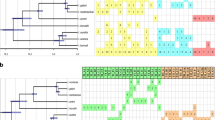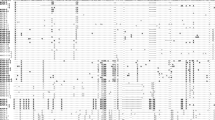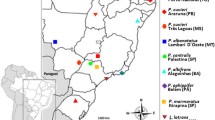Abstract
On the basement of the library model of satellite DNA evolution is the differential amplification of subfamilies through lineages diversification. However, this idea has rarely been explored from an experimental point of view. In the present work, we analyzed copy number and sequence variability of RPCS (repetitive PvuII Ctenomys sequence), the major satellite DNA present in the genomes of the rodents of the genus Ctenomys, in a closely related group of species and forms inhabiting the Iberá marsh in Argentina. We studied the dependence of these two parameters at the intrapopulation level because in the case of interbreeding genomes, differences in RPCS copy number are due to recent amplification/contraction events. We found an inverse relationship among RPCS copy number and sequence variability: amplifications lead to a decrease in sequence variability, by means of biased homogenization of the overall satellite DNA, prevailing few variants. On the contrary, the contraction events that involve tandems of homogeneous monomers contribute—by default—minor variants to become “evident”, which otherwise were undetectable. On the other hand, all the RPCS sequence variants are totally or partially shared by all the studied populations. As a whole, these results are comprehensible if these RPCS variants preexisted in the common ancestor of this Ctenomys group.


Similar content being viewed by others
References
Anderson S, de Bruijn MH, Coulson AR, Eperon IC, Sanger F, Young IG (1982) Complete sequence of bovine mitochondrial DNA. Conserved features of the mammalian mitochondrial genome. J Mol Biol 156:683–717
Argüelles CF, Suárez P, Giménez MD, Bidau CJ (2001) Intraspecific chromosome variation between different populations of Ctenomys dorbignyi (Rodentia, Ctenomyidae) from Argentina. Acta Theriol 46(4):363–373
Bruvo-Madaric B, Plohl M, Ugarković D (2007) Wide distribution of related satellite DNA families within the genus Pimelia (Tenebrionidae). Genetica 130:35–42
Capanna E, Castiglia R (2004) Chromosomes and speciation in Mus musculus domesticus. Cytogenet Genome Res 105:375–384
Carpentier G (2008) Dot blot analyzer: software development using the macro language of imageJ. ImageJ User and Developer Conference proceedings
Castiglia R, Garagna S, Merico V, Oguge N, Corti M (2006) Cytogenetics of a new cytotype of African Mus (subgenus Nannomys) minutoides (Rodentia, Muridae) from Kenya: C- and G- banding and distribution of (TTAGGG)n telomeric sequences. Chromosome Res 14:587–594
Dobigny G, Aniskin V, Granjon L, Cornette R, Volobouev V (2005) Recent radiation in West African Taterillus (Rodentia, Gerbillinae): the concerted role of chromosome and climatic changes. Heredity 95:358–368
Dover GA, Tautz D (1986) Conservation and divergence in multigene families: alternatives to selection and drift. Philos Trans R Soc Lond B Biol Sci 312:275–289
Ellingsen A, Slamovits CH, Rossi MS (2007) Sequence evolution of the major satellite DNA of the genus Ctenomys (Octodontidae, Rodentia). Gene 392:283–290
Excoffier L, Laval G, Schneider S (2005) Arlequin (version 3.0): An integrated software package for population genetics data analysis. Evol Bioinform Online 1:47–50
Fronicke L, Scherthan H (1997) Zoo-fluorescence in situ hybridization analysis of human and Indian muntjac karyotypes (Muntiacus muntjak vaginalis) reveals satellite DNA clusters at the margins of conserved syntenic segments. Chromosome Res 5:254–261
Fry K, Salser W (1977) Nucleotide sequences of HS-alpha satellite DNA from kangaroo rat Dipodomys ordii and characterization of similar sequences in other rodents. Cell 12:1069–1084
García L, Ponsà M, Egozcue J, García M (2000) Cytogenetic variation in Ctenomys perrensi (Rodentia, Octodontidae). Biol J Linn Soc 69:103–120
Giménez MD, Mirol PM, Bidau CJ, Searle JB (2002) Molecular analysis of populations of Ctenomys (Caviomorpha, Rodentia) with high karyotypic variability. Cytogenet Genome Res 96:130–136
Grewal SI, Elgin SC (2007) Transcription and RNA interference in the formation of heterochromatin. Nature 447:399–406
Hartmann N, Scherthan H (2004) Characterization of ancestral chromosome fusion points in the Indian muntjac deer. Chromosoma 112:213–220
Henikoff S, Dalal Y (2005) Centromeric chromatin: what makes it unique? Curr Opin Genet Dev 15:177–184
Henikoff S, Ahmad K, Malik HS (2001) The centromere paradox: stable inheritance with rapidly evolving DNA. Science 293:1098–1102
Kiblisky P, Brum-Zorrilla N, Perez G, Saez F (1977) Variabilidad cromosómica entre diversas poblaciones uruguayas del roedor cavador del genero Ctenomys (Rodentia-Octodontidae). Mendeliana 2:85–93
Lam AL, Boivin CD, Bonney CF, Rudd MK, Sullivan BA (2006) Human centromeric chromatin is a dynamic chromosomal domain that can spread over noncentromeric DNA. Proc Natl Acad Sci USA 103:4186–4191
Lanzone C, Bidau CJ, Giménez MD, Santos JL (2002) Synaptic behaviour and morphological modifications of the X and Y chromosomes during pachytene in three species of Ctenomys (Rodentia, Caviomorpha, Ctenomyidae). Genome 45:1110–1115
Li YC, Lee C, Sanoudou D, Hseu TH, Li SY, Lin CC (2000) Interstitial colocalization of two cervid satellite DNAs involved in the genesis of the Indian muntjac karyotype. Chromosome Res 8:363–373
Luchetti A, Marini M, Mantovani B (2006) Non-concerted evolution of the RET76 satellite DNA family in Reticulitermes taxa (Insecta, Isoptera). Genetica 128:123–132
Matsubara K, Yamada K, Umemoto S, Tsuchiya K, Ikeda N, Nishida C, Chijiwa T, Moriwaki K, Matsuda Y (2008) Molecular cloning and characterization of the repetitive DNA sequences that comprise the constitutive heterochromatin of the A and B chromosomes of the Korean field mouse (Apodemus peninsulae, Muridae, Rodentia). Chromosome Res 16:1013–1026
Meštrović N, Plohl M, Mravinac B, Ugarković D (1998) Evolution of satellite DNAs from the genus Palorus–experimental evidence for the “library” hypothesis. Mol Biol Evol 15:1062–1068
Meštrović N, Castagnone-Sereno P, Plohl M (2006) Interplay of selective pressure and stochastic events directs evolution of the MEL172 satellite DNA library in root-knot nematodes. Mol Biol Evol 23:2316–2325
Ortells MO, Barrantes GE (1994) Genetic distances and variability study in several species of the genus Ctenomys (Rodentia: Octodontidae), with special reference to a probable causal role of chromosomes in speciation. Biol J Linn Soc 53:189–208
Ortells MO, Contreras JR, Reig OA (1990) New Ctenomys karyotypes (Rodentia, Octodontidae) from north-eastern Argentina and from Paraguay confirm the extreme chromosomal multiformity of the genus. Genetica 82:189–201
Picariello O, Feliciello I, Bellinello R, Chinali G (2002) S1 satellite DNA as a taxonomic marker in brown frogs: molecular evidence that Rana graeca graeca and Rana graeca italica are different species. Genome 45:63–70
Plohl M, Luchetti A, Meštrović N, Mantovani B (2008) Satellite DNAs between selfishness and functionality: structure, genomics and evolution of tandem repeats in centromeric (hetero)chromatin. Gene 409:72–82
Pons J, Gillespie RG (2004) Evolution of satellite DNAs in a radiation of endemic Hawaiian spiders: does concerted evolution of highly repetitive sequences reflect evolutionary history? J Mol Evol 59:632–641
Reig OA, Massarini AI, Ortells MO, Barros MA, Tiranti SI, Dyzenchauz FJ (1992) New karyotypes and C-banding patterns of the subterranean rodents of the genus Ctenomys (Caviomorpha, Octodontidae) from Argentina. Mammalia 54:603–623
Rossi MS, Reig OA, Zorzopulos J (1990) Evidence for rolling-circle replication in a major satellite DNA from the South American rodents of the genus Ctenomys. Mol Biol Evol 7:340–350
Rossi MS, Pesce CG, Reig OA, Kornblihtt AR, Zorzopulos J (1993a) Retroviral-like features in the monomer of the major satellite DNA from the South American rodents of the genus Ctenomys. DNA Seq 3:379–381
Rossi MS, Reig OA, Zorzopulos J (1993b) A major satellite DNA from the South American rodents of the genus Ctenomys: quantitative and qualitative differences in species with different geographic distribution. Z Säugetierk 58:244–251
Rossi MS, Redi CA, Viale G, Massarini AI, Capanna E (1995) Chromosomal distribution of the major satellite DNA of South American rodents of the genus Ctenomys. Cytogenet Cell Genet 69:179–184
Ruedas LA, Cook JA, Yates TL, Bickham JW (1993) Conservative genome size and rapid chromosomal evolution in the South American tuco-tucos (Rodentia: Ctenomyidae). Genome 36:449–458
Shestakova EA, Mansuroglu Z, Mokrani H, Ghinea N, Bonnefoy E (2004) Transcription factor YY1 associates with pericentromeric gamma-satellite DNA in cycling but not in quiescent (G0) cells. Nucleic Acids Res 32:4390–4399
Slamovits CH, Cook JA, Lessa EP, Rossi MS (2001) Recurrent amplifications and deletions of satellite DNA accompanied chromosomal diversification in South American tuco-tucos (genus Ctenomys, Rodentia: Octodontidae): a phylogenetic approach. Mol Biol Evol 18:1708–1719
Swofford DL (2002) PAUP: phylogenetic analysis using parsimony (and other methods), version 4 Sinauer Associates Inc. Publishers, Sunderland, MA, USA
Ugarković D, Plohl M (2002) Variation in satellite DNA profiles–causes and effects. EMBO J 21:5955–5959
Woods C, Kilpatrick C (2005) Infraorder hystricognathi brandt, 1855. In: Wilson DE, Reeder DM (eds) Mammal species of the world: a taxonomic and geographic reference, 3rd edn. John Hopkins University Press, Baltimore, pp 1538–1600
Acknowledgments
This work was supported by grants from the Agencia Nacional de Investigaciones Científicas y Técnicas (PICT 3836/1) and Consejo Nacional de Investigaciones Científicas y Técnicas (PIP 5776) from Argentina. D.A.C. is supported by a doctoral fellowship awarded by CONICET. M. S. R. is career investigator of the CONICET. We would like to thank Mercedes Goin and Diana Avedikian, and also three anonymous reviewers for their comments on the first version of the manuscript. We also would like to thank Thales R. de Freitas, María Jimena Gómez Fernandez, Marcelo Kittlien, Fernando Mapelli, Patricia Mirol, Matías Mora, Vanina Raimondi, Verónica Trucco Cano and Laura Wolfenson for assistance at the fieldwork.
Author information
Authors and Affiliations
Corresponding author
Rights and permissions
About this article
Cite this article
Caraballo, D.A., Belluscio, P.M. & Rossi, M.S. The library model for satellite DNA evolution: a case study with the rodents of the genus Ctenomys (Octodontidae) from the Iberá marsh, Argentina. Genetica 138, 1201–1210 (2010). https://doi.org/10.1007/s10709-010-9516-2
Received:
Accepted:
Published:
Issue Date:
DOI: https://doi.org/10.1007/s10709-010-9516-2




